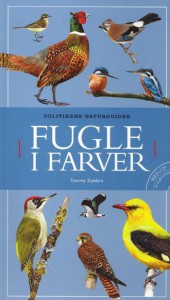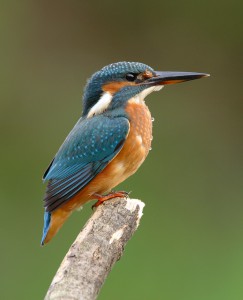Falling Down the Thames Blog 26, 10th September 2014
A Wealth of Kingfishers
As described last week, the symbol for the 2015 paddling adventure of Krista and I is the Common Kingfisher. It is a shy but beautiful blue-and-orange bird which we should spy along many segments of the River Thames.
Krista’s father, Jørgen, gave me his copy of a book published in 1955 entitled Fugle I Farver. This translates from Danish to English as Birds in Colour. From Fugle I Farver I learned that:
“Ret sjælden ynglefugl, almindeligst i Østjylland. Isfuglen bliver her hele året. Den styrtykker efter småfisk, vandinsekter g krebsdyr. Den bygger rede i åbrinker, hvor den hugger det lange vendrette indgangsrør og redestedet ud med næbbet. Æglægningen finder sted i maj. De 6-7 glinsende hvide æg bliver lagt uden underlag, blot omgivet af en krans opgylpede fiskekogler.”
And just in case you don’t speak Danish, this translates roughly as:
“A rare breeding bird seen most commonly in East Jutland. The kingfisher is a resident. It feeds by swooping on small fish, aquatic insects and crustaceans…”
But the online translation program I used had a bit of difficulties with the fourth sentence, offering:
“…The nesting åbrinker where the chipper the long turn right inlet and the nesting area out of its beak.”
I then learned that breeding takes place in May. Six or seven glistening white eggs are laid without formal nesting material, but rather surrounded by a wreath of regurgitated fish bones.
I got additional information about the Common Kingfisher from a 1943 British book in my collection entitled A Bird Book for the Pocket. I gather that we will be paddling down the Thames at just the right time of year to see both parents-to-be excavating nest burrows in steep banks. We should expect them to pass us swiftly, low to the water. It seems that these birds, while hunting, are even capable of hovering motionless before plunging into the water.
Finally I consulted the Reader’s Digest Field Guide to the Birds of Britain. It offered a little factoid that I had not come across before. “The kingfisher,” I read, “is seldom preyed upon by other birds, as its flesh has an unpleasant taste.” Perhaps that is a result of eating so many fish.
According to the International Union for the Conservation of Nature, we don’t have to worry too much about the plight of the Common Kingfisher which is considered to be of “Least Concern.” It has a huge distribution across Europe, Asia and the Middle East. Its current population is estimated to be about 600,000 individuals. But before celebrating the abundance of our kingfisher, it is important to remember that there are fewer of them, spread over a vast range, than there are humans living in Greater Bristol.
- Glen
Photo credits: Fugle I Farver - www.arnoldbusck.dk; Common Kingfisher - ibc.lynxeds.com



